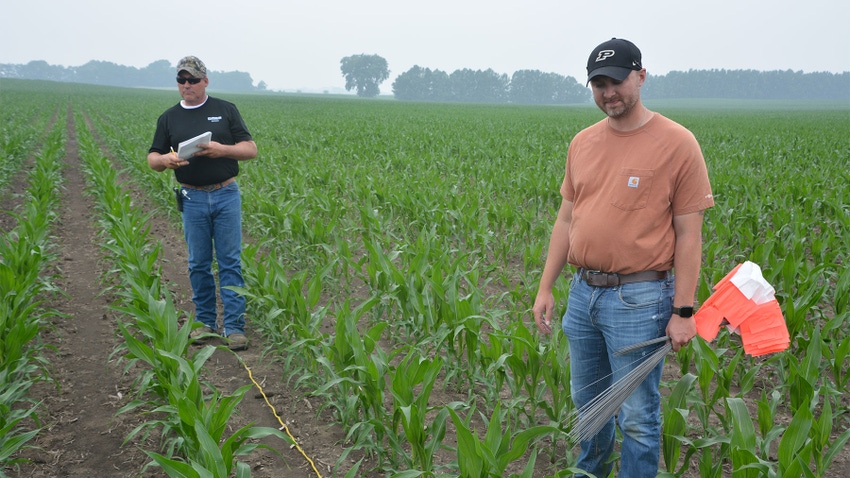March 12, 2024

At a Glance
- In a Purdue study, active downforce systems that adjust on the go improved yield.
- Yield was not statistically higher for 2-inch vs. 3-inch depth.
- Final plant population was significantly higher at 2-inch vs. 3-inch depth.
Rapid and uniform emergence is an essential component to achieving high corn yields. Proper seed placement and depth with adequate moisture is necessary for successful emergence and to prevent the seed from being exposed to poor environmental conditions. In addition, uniform emergence gives each plant equal opportunities for nutrients, water and sunlight.
Correct and consistent seed depth is an important aspect of achieving uniform plant emergence. Achieving correct depth requires proper planter downforce. Downforce is the amount of load applied to the planter row unit to place seeds at consistent depths.
Downforce basics
This load consists of the weight of the individual row unit and any additional load that can be applied through mechanical springs, air bags or hydraulics. Now, companies offer systems that can be used to vary load requirements on the go due to variable soil conditions.
Active hydraulic downforce systems can sense row-by-row feedback from load sensor readings on the planter gauge wheels. Then, the system can either apply downforce or supply lift to maintain gauge wheel ground contact.
These systems may be especially beneficial in high-residue fields, or where residue levels vary across the field. They can avoid issues where either too much or too little downforce is applied. Too much downforce on row units can lead to soil compaction. Too little downforce may result in shallow seeding depth.
Testing the concept
In 2023, an Indiana Prairie Farmer and Purdue University joint trial sought to test impacts of corn plant population and yield in response to active and static downforce settings across multiple hybrids and multiple targeted seeding depths. The research trial was performed at the Throckmorton Purdue Agricultural Center near Lafayette, Ind.
Treatments were replicated three times and randomized at field-scale. Plots measured 12 rows wide by 400 feet long. Treatments were planted with a John Deere 7000 Series planter equipped with the DeltaForce active downforce system from Precision Planting, based in Tremont, Ill.
It uses load cells to actively measure individual row-unit gauge-wheel downforce and adjusts applied downforce or lift based on sensor readings and conditions. The targeted seeding rate for the study was 30,000 seeds per acre.
Two hybrids were included at two depths: 2 inches and 3 inches. The final variable was downforce. The downforce system in the active setting, where it adjusted automatically based on soil and residue conditions, was compared to applying a constant downforce of 100 pounds.
Beck’s provided seed for the study. Thanks go out to Pete Illingworth and crew at TPAC for assisting in the trial. Stands were tracked for differences in emergence. Populations were taken by walking the field at the V8 stage, and harvest stand counts were made to make sure all potential differences were captured. Only harvest populations are included in the results table (below).

Deciphering results
No interactions between hybrid type and seeding depth on yield and plant population response to static vs. active downforce were observed. This means there was no indication that static or active downforce differed in its response based on hybrid type or targeted depth, either 2 or 3 inches.
However, there were statistical differences in final plant population and yield among the main factors of the study. These include hybrid type, depth and downforce. Final plant population was improved by 4% with a 2-inch planting depth vs. 3-inch planting depth. The use of active downforce vs. a standard 100 pounds increased plant population 3%.
Corn yield differences were observed between hybrids and downforce settings. In this study, Hybrid 1 outyielded Hybrid 2 by an average of 15 bushels per acre. Active downforce improved corn yield by 8 bushels per acre in comparison to static downforce, averaged across both hybrids.
This yield difference was likely due to reduced final plant stand observed with static downforce settings. Those may have been a function of less consistent seed depth and planter ground contact due to variable field conditions.
Overall, preliminary results indicate benefits for an active downforce system vs. a static downforce system on corn final plant population and yield. In this field, there are six different soil types, and elevation changes reach upward of 13 feet.
Therefore, benefits may be most pronounced in variable soil conditions. These include differences in soil type, elevation and residue levels. The goal is to conduct a similar trial again in 2024 to further study the impact of active downforce on plant population and yield.
About the Author(s)
You May Also Like




